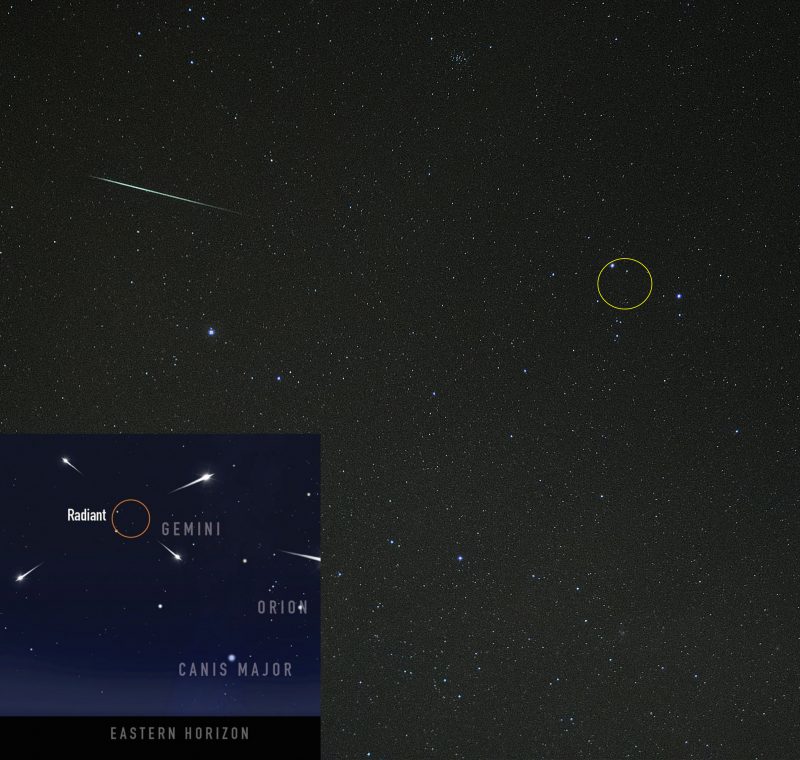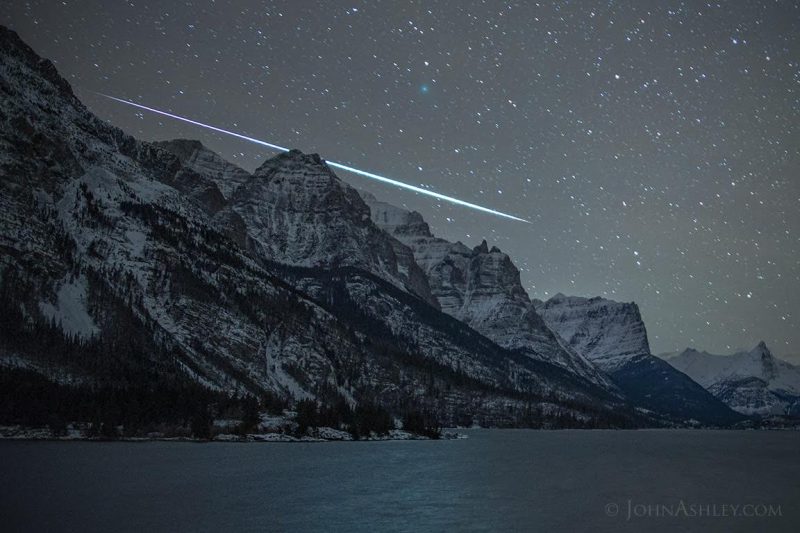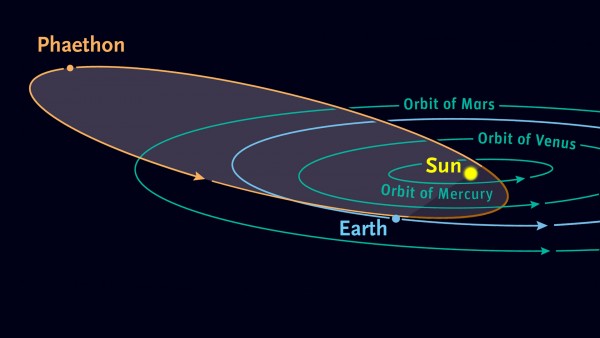
The 2020 Geminid meteor shower is expected to produce the greatest number of meteors on the night of December 13-14 (Sunday night until dawn Monday). There’s never any certainty about meteor showers. They’re like fishing … you go, and sometimes you catch a big one! But Monday morning is a good bet. That’s true no matter where you live on Earth’s globe. Although meteors tend to be bright, you’ll want a dark sky. On a dark night, with no moon (as is the case this year), you can easily spot 50 or more meteors per hour. On an optimum night for the Geminids, you might spot 100 meteors or more per hour. A thrill!
Also know that – although this is one shower you can successfully watch in the (late) evening – the best viewing is typically around 2 a.m., no matter where you are on Earth.
Remember … meteors in annual showers typically come in spurts, interspersed by lulls. So give yourself at least an hour of observing time. Simply sprawl out on a reclining lawn chair, look upward and enjoy the show.

Veteran meteor photographer Eliot Herman in Tucson, Arizona, captured this Geminid meteor flying from the radiant point on December 8, 2018. Note that the inset is our radiant point chart, shown at the top of this post. Thanks, Eliot!
It’s around 2 a.m. that the the shower’s radiant point – near the bright star Castor in the constellation Gemini – is highest in the sky. That’s true no matter where you live on the globe.
If you’re not one to stay up late, you can watch for meteors during the evening hours. Although the meteors will be few and far between at early-to-mid evening, you might, if you’re lucky, catch an earthgrazer – a sloow-moving and loong-lasting meteor that travels horizontally across the sky.

John Ashley in Glacier National Park, Montana, caught this amazing earthgrazer meteor on December 6, 2018. Earthgrazers are best seen in the evening hours. Watch for them during this week’s Geminid meteor shower! John said this one lasted approximately 4 seconds and left behind a glowing smoke train that lasted at least 24 minutes. He commented: “The meteor went dark just above Dusty Star Mountain, or ‘Iszika-kakatosi’ in Blackfeet, which translates to ‘smoking star.'” Cool! Thanks, John! Nikon D750, Rokinon 24mm lens @ f1.4, 30 sec, ISO 3200.
Can you watch from the Southern Hemisphere? Sure! At temperate latitudes in the Southern Hemisphere, the meteors tend to be fewer. The Geminids do favor the Northern Hemisphere, where the radiant appears higher in the sky. However, this shower is also visible from the tropical and subtropical parts of the Southern Hemisphere.
How many meteors will you see? The Geminids are a consistent and prolific shower, but the numbers of meteors you see also strongly depends on your sky conditions and on how far you are from city lights. Often, in the hours after midnight and under a dark sky, you can see 50 or more meteors per hour. Rates of 100 per hour – or higher – have been reported at the peak under optimum sky conditions.
In 2020, the moon-free skies guarantee dark skies this year’s shower. How many will you see? Hard to say for sure! Just watch, and let us know.
Where do the meteors come from? Although meteors are sometimes called “shooting stars,” they have nothing to do with stars. Instead, they are strictly a solar system phenomenon. Around this time every year, our planet Earth crosses the orbital path of a mysterious object called 3200 Phaethon, which has an asteroid name, but a comet-like tail. Debris from this object burns up in the Earth’s upper atmosphere to give us the annual Geminid meteor shower.
EarthSky lunar calendars are cool! They make great gifts. Order now. Going fast!

Orbital path of 3200 Phaethon, the parent object of the Geminid meteors, via skyandtelescope.com.
Bottom line: With the moon out of the sky all night long, this year’s Geminid meteor shower will not be obstructed by moonlight. Peak morning is probably December 14, but watch December 15, too.
Read more: 10 tips for watching the Geminids
Read more: Find the Geminid meteors’ radiant point
Read more: All you need to know about the Geminid meteor shower
Read more about 3200 Phaethon: The mysterious source of the Geminid meteor shower
from EarthSky https://ift.tt/2QIqicy

The 2020 Geminid meteor shower is expected to produce the greatest number of meteors on the night of December 13-14 (Sunday night until dawn Monday). There’s never any certainty about meteor showers. They’re like fishing … you go, and sometimes you catch a big one! But Monday morning is a good bet. That’s true no matter where you live on Earth’s globe. Although meteors tend to be bright, you’ll want a dark sky. On a dark night, with no moon (as is the case this year), you can easily spot 50 or more meteors per hour. On an optimum night for the Geminids, you might spot 100 meteors or more per hour. A thrill!
Also know that – although this is one shower you can successfully watch in the (late) evening – the best viewing is typically around 2 a.m., no matter where you are on Earth.
Remember … meteors in annual showers typically come in spurts, interspersed by lulls. So give yourself at least an hour of observing time. Simply sprawl out on a reclining lawn chair, look upward and enjoy the show.

Veteran meteor photographer Eliot Herman in Tucson, Arizona, captured this Geminid meteor flying from the radiant point on December 8, 2018. Note that the inset is our radiant point chart, shown at the top of this post. Thanks, Eliot!
It’s around 2 a.m. that the the shower’s radiant point – near the bright star Castor in the constellation Gemini – is highest in the sky. That’s true no matter where you live on the globe.
If you’re not one to stay up late, you can watch for meteors during the evening hours. Although the meteors will be few and far between at early-to-mid evening, you might, if you’re lucky, catch an earthgrazer – a sloow-moving and loong-lasting meteor that travels horizontally across the sky.

John Ashley in Glacier National Park, Montana, caught this amazing earthgrazer meteor on December 6, 2018. Earthgrazers are best seen in the evening hours. Watch for them during this week’s Geminid meteor shower! John said this one lasted approximately 4 seconds and left behind a glowing smoke train that lasted at least 24 minutes. He commented: “The meteor went dark just above Dusty Star Mountain, or ‘Iszika-kakatosi’ in Blackfeet, which translates to ‘smoking star.'” Cool! Thanks, John! Nikon D750, Rokinon 24mm lens @ f1.4, 30 sec, ISO 3200.
Can you watch from the Southern Hemisphere? Sure! At temperate latitudes in the Southern Hemisphere, the meteors tend to be fewer. The Geminids do favor the Northern Hemisphere, where the radiant appears higher in the sky. However, this shower is also visible from the tropical and subtropical parts of the Southern Hemisphere.
How many meteors will you see? The Geminids are a consistent and prolific shower, but the numbers of meteors you see also strongly depends on your sky conditions and on how far you are from city lights. Often, in the hours after midnight and under a dark sky, you can see 50 or more meteors per hour. Rates of 100 per hour – or higher – have been reported at the peak under optimum sky conditions.
In 2020, the moon-free skies guarantee dark skies this year’s shower. How many will you see? Hard to say for sure! Just watch, and let us know.
Where do the meteors come from? Although meteors are sometimes called “shooting stars,” they have nothing to do with stars. Instead, they are strictly a solar system phenomenon. Around this time every year, our planet Earth crosses the orbital path of a mysterious object called 3200 Phaethon, which has an asteroid name, but a comet-like tail. Debris from this object burns up in the Earth’s upper atmosphere to give us the annual Geminid meteor shower.
EarthSky lunar calendars are cool! They make great gifts. Order now. Going fast!

Orbital path of 3200 Phaethon, the parent object of the Geminid meteors, via skyandtelescope.com.
Bottom line: With the moon out of the sky all night long, this year’s Geminid meteor shower will not be obstructed by moonlight. Peak morning is probably December 14, but watch December 15, too.
Read more: 10 tips for watching the Geminids
Read more: Find the Geminid meteors’ radiant point
Read more: All you need to know about the Geminid meteor shower
Read more about 3200 Phaethon: The mysterious source of the Geminid meteor shower
from EarthSky https://ift.tt/2QIqicy

Aucun commentaire:
Enregistrer un commentaire